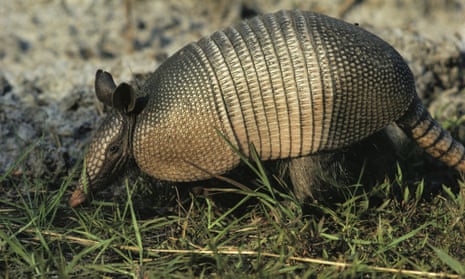Health officials on the east coast of Florida have diagnosed three cases of leprosy in the last five months, linking two of the cases to contact with armadillos. The small armored mammals are known to harbor the disease in the southern US.
The cases were confirmed in Volusia County, Florida, which is home to about 500,000 people and tourist cities such as Daytona Beach. Health officials believe the three cases developed independently.
Though such a cluster of cases of leprosy is uncommon, experts say the general public has little to worry about. About 95% of the population is not susceptible to leprosy, also called Hansen’s disease, which can be cured with antibiotics. Also, only the nine-banded armadillo carries leprosy. The common five-banded armadillo does not.
“People are generally astonished to find out this disease still exists in the world,” said Dr David Scollard, director of the National Hansen’s Disease (Leprosy) Program.
A large concentration of US leprosy cases are diagnosed in the south-east, in states such as Florida, Louisiana and Texas. Scollard’s team is part of a federal effort to research the disease and combat misperceptions among the public.
The link between leprosy infections and armadillo contact was established in a 2011 research paper published in the New England Journal of Medicine by a team which includes Scollard. The scientists genotyped strains of leprosy found in three Americans who had never traveled abroad and one wild armadillo, and found they “were essentially identical”.
“There’s a fair amount of interaction between armadillos and people,” Scollard said. “Down here, they’re common. And in Louisiana, and especially in Texas, people see armadillos in the garden, they keep them as pets, they shoot them and eat them – there’s more interaction with armadillos than you might think.”
Leprosy is a bacterial skin and nerve infection that can impede sufferers’ ability to feel pain and lead to tough patches, growths or lesions on the skin.
Though pictures of toeless feet and fingerless hands populate leprosy’s lore, doctors now consider such outcomes uncommon, Scollard said. Most often, patients with such extreme conditions lack proper medical care to treat ancillary infections brought on by cuts that go unnoticed because of nerve damage. If caught early, leprosy can be treated and cured with an up to two-year regimen of antibiotics.
“The fear of this disease is really irrational and inordinate. There are other diseases that are much more problematic than this,” Scollard said. “These stigma are sometimes more injurious to the person than the disease itself.”
How leprosy is contracted remains a mystery. Studying the disease is difficult, because it does not grow in normal lab cultures and appears only to affect humans and armadillos.
Scollard believes humans actually gave armadillos leprosy a few hundred years ago, the germs since propagating naturally among armadillos.
The disease is also incredibly rare. About 3,300 leprosy are being actively managed by doctors in the entire US, placing it far below the threshold for which diseases are considered “rare” by the National Organization for Rare Diseases.
In the US, a disease is considered rare when it affects fewer than 200,000 Americans. In 2009, the most recent year for which data is available, the National Hansen’s Disease (Leprosy) Program reported 213 new cases.
Scollard said such a clustered diagnosis in Volusia County could be the effect of an ascertainment bias – a medical term roughly meaning that an outcome is more likely when people are aware of it.
In the case of Volusia County, that means physicians could be diagnosing leprosy because they now know it is in the area.

Comments (…)
Sign in or create your Guardian account to join the discussion